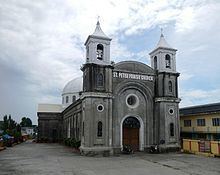Location Apalit, Pampanga Denomination Roman Catholic Architectural type Church building Archbishop Florentino Lavarias | Country Philippines Functional status Active Status Parish church | |
 | ||
Archdiocese Roman Catholic Archdiocese of San Fernando Similar San Andres Apostol C, San Agustin Church, Santa Catalina de Alejandri, Betis Church, Santa Catalina Parish Ch | ||
Apalit Church is a Neo-Renaissance-style church located at Apalit, in the province of Pampanga, Philippines. The additional construction of the two towers beside the church served as reinforcements to improve the structural integrity of the church. Also, the church houses bells manufactured by the Sunicos.
Contents
History
In 1597, Apalit Parish of Saint Peter was created after its separation from the Parish of Calumpit. Fr. Pedro de Vergara was the first parish priest of Apalit. A traditional fluvial parade known as Apung Iru or Libad Festival was initiated by Capitan del Pueblo Don Pedro Armayan Espiritu on June 28, 1844, in honor of St. Peter.
Fr. Juan Cabello
Fr. Simon de Alarcia
Fr. Antonio Redondo
Fr. Toribio Fanjul
Msgr. Rustico G. Cuevas
Architectural features
Apalit Church measures 59 meters long and 14 meters wide. The facade resembles Neo-Renaissance Style with its plain, low segmental pediment and the symmetrical alignment of 2 flanking towers. The semi-circular main door with a circular window above is framed by receding semicircular arches in relief.
The ceiling art paintings, also known as trompe l'oeil were done by a native of Apalit, under the supervision of Caesare Alberoni, an Italian free-lance painter. One notable ceiling art paintings was located in the cupola of the Apalit Church, giving a rendition of the Apocalypse.
There are 6 bells located at the Apalit Church, 5 of which came from Fundicion de Hilario Sunico Jaboneros.
Below were the list of the bells with corresponding inscriptions:
Marker from the National Historical Commission of the Philippines
The marker of Church of Apalit was installed in 1939 at Apalit, Pampanga. It was installed by Philippines Historical Committee (now National Historical Commission of the Philippines).
